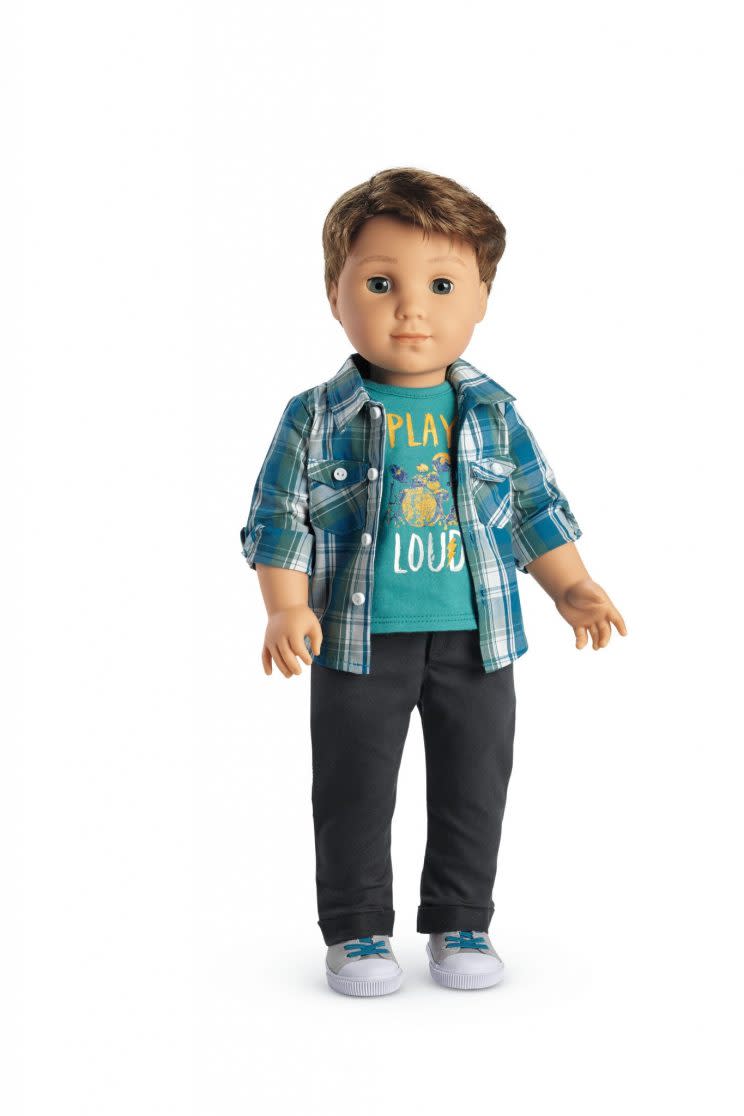The Larger Impact of American Girl Introducing Its First Boy Doll

Doll company American Girl is breaking major barriers with its first boy doll.
Logan Everett, an 18-inch-tall drummer boy, will be released on Thursday. According to a statement sent to Yahoo Beauty, the boy character has been a “top request” from customers demanding “more experiences, more diversity, more interests.”
The 33-year-old company launched as an alternative to Cabbage Patch Kids and Barbie dolls, which dominated toy store aisles in the 1980s. “Here I was, in a generation of women at the forefront of redefining women’s roles, and yet our daughters were playing with dolls that celebrated being a teen queen or a mommy,” founder Pleasant Rowland told CNN Money in 2002. The idea was to create 9-year-old female dolls, based on a book series, from various historical eras, complete with fascinating detailed childhoods, outfits, and accessories.
Although the overwhelming success of American Girl has evolved into retail stores, a discontinued toddler doll line, and a magazine, the company has faced its share of controversy: eye-popping prices (each doll is roughly $100), stereotypical book scenes, and its decision to discontinue two dolls of color, an African-American doll named Cecile and an Asian-American doll named Ivy.
Logan is part of the brand’s 2017 collection, which includes a Korean-American doll named Z Yang and a Hawaiian doll from the World War II era named Nanea.
While children’s toys and clothing remain largely gender-specific, over the past several years, companies have been breaking pink and blue barriers, thanks in part to social media activism. In 2015, Target announced it was phasing out gender-based signage in its bedding and toy sections, including more subtle cues like pink, blue, and yellow shelf paper. In 2013, Hasbro debuted a gender-neutral Easy-Bake Oven, and clothing brand Zara introduced its “genderless” line. Toy companies such as GoldieBlox use science, technology, engineering, and mathematics themes to engage female customers, while celebrities such as Jaime King and Jaden Smith own gender-free clothing lines.
Research shows that gender bias is both cultural and biological. “Both boy and girl infants prefer dolls possibly because we’re hardwired to prefer human voices and faces,” Christia Brown, a professor of developmental psychology and author of Parenting Beyond Pink and Blue, tells Yahoo Beauty.
The real gender divide starts around age 2, when kids learn the concept of gender from television ads, preschool, or parental influence. “For example, if you hand a girl a pink toy with a girl pictured on the box and tell her ‘It’s for girls,’ she’ll express preference for that toy and play with it for longer,” says Brown. “It’s not about the toy itself, but the expectation.”
Logan is a welcome addition, says Brown, because while toy companies have come around to marketing typical “boy” products to girls, with the exception of the updated Easy-Bake Oven, the opposite trend hasn’t caught on. “Culture is much more ridged for boys, many of whom aren’t celebrated for their nurturing side,” says Brown. “This doll for boys is newsworthy.”
Read More:
Say Hello to the Newest Kinky-Haired Doll for Kids
A Mom Made a Breastfeeding Barbie to Teach Kids About Parenting
Is Having Twin Babies, Like George and Amal, the New Thing?
Let’s keep in touch! Follow Yahoo Beauty on Facebook, Twitter, Instagram, and Pinterest.
